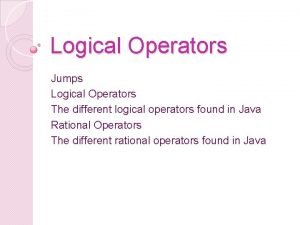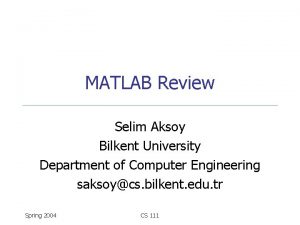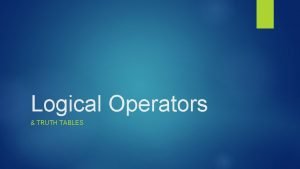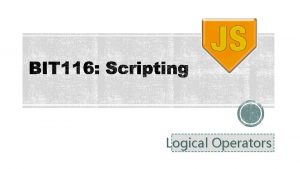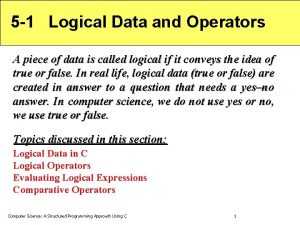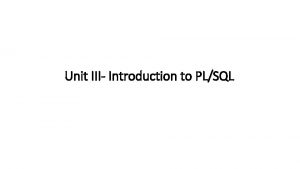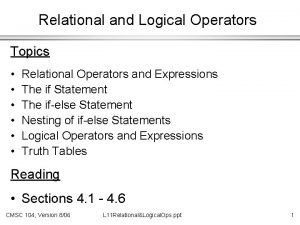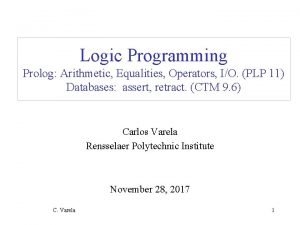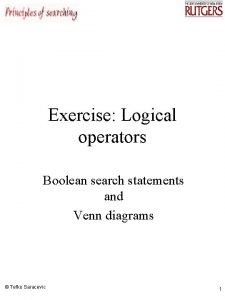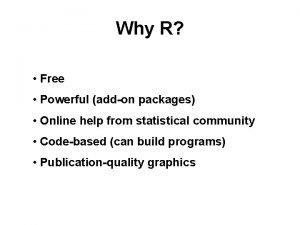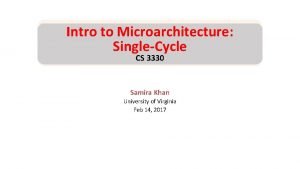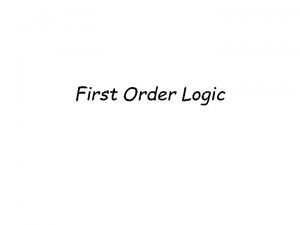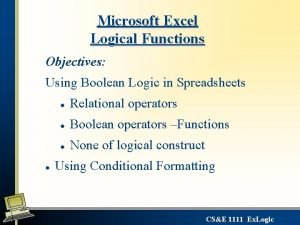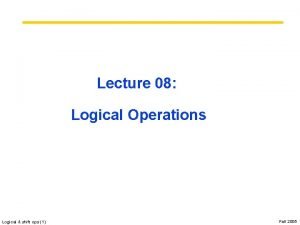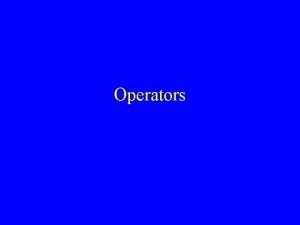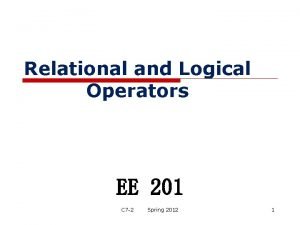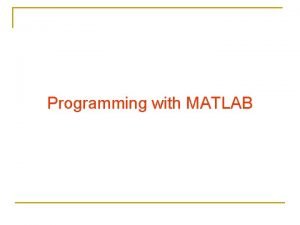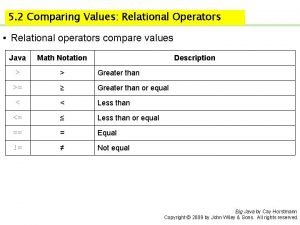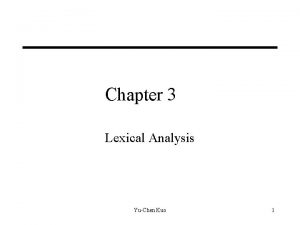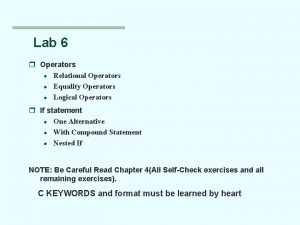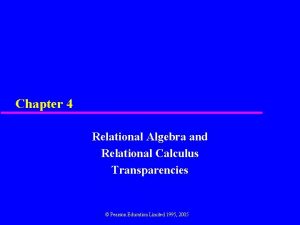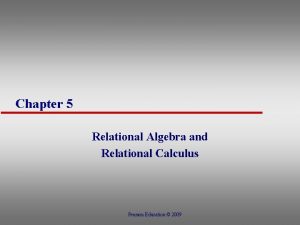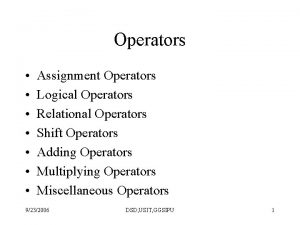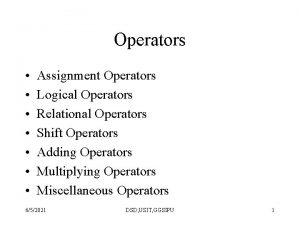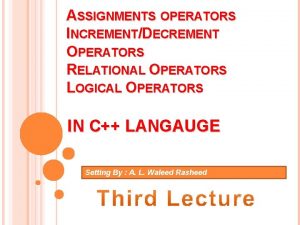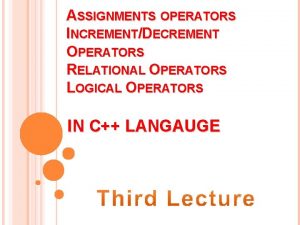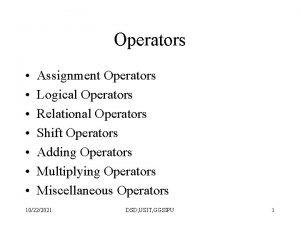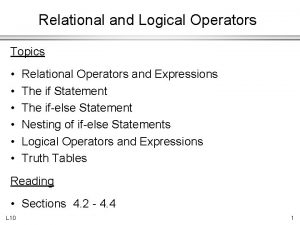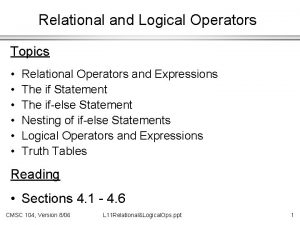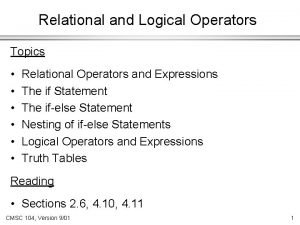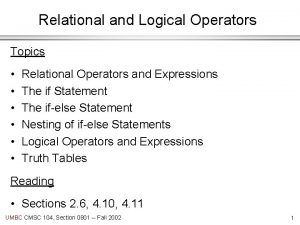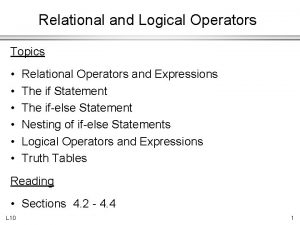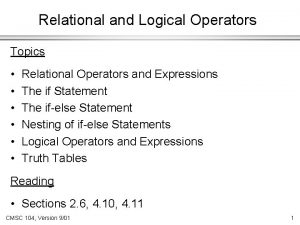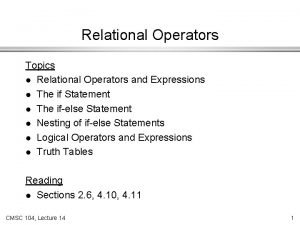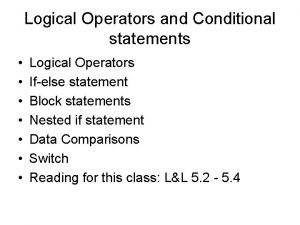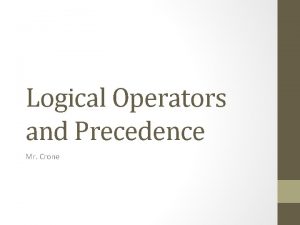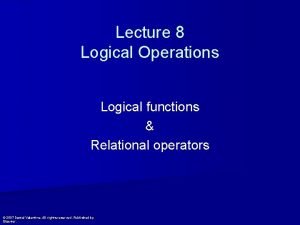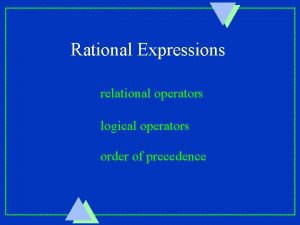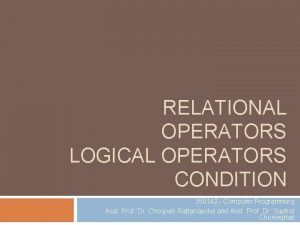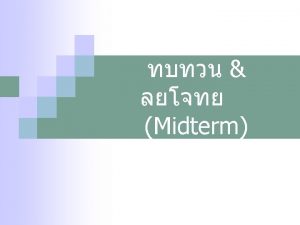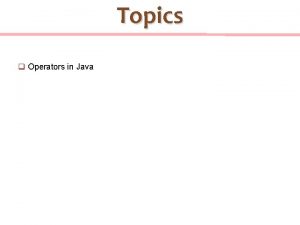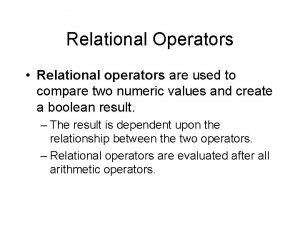Relational and Logical Operators Topics Relational Operators and



























- Slides: 27

Relational and Logical Operators Topics • • • Relational Operators and Expressions The if Statement The if-else Statement Nesting of if-else Statements Logical Operators and Expressions Truth Tables Reading • Sections 2. 6, 4. 10, 4. 11 CMSC 104, Version 9/01 1

Relational Operators < > <= >= == != less than greater than less than or equal to greater than or equal to is not equal to Relational expressions evaluate to the integer values 1 (true) or 0 (false). All of these operators are called binary operators because they take two expressions as operands. CMSC 104, Version 9/01 2

Practice with Relational Expressions int a = 1, b = 2, c = 3 ; Expression Value a < c b <= c c <= a a>b b >= c CMSC 104, Version 9/01 Expression a + b >= c a + b == c a != b a + b != c Value 3

Arithmetic Expressions: True or False • Arithmetic expressions evaluate to numeric values. • An arithmetic expression that has a value of zero is false. • An arithmetic expression that has a value other than zero is true. CMSC 104, Version 9/01 4

Practice with Arithmetic Expressions int a = 1, b = 2, c = 3 ; float x = 3. 33, y = 6. 66 ; Expression Numeric Value a+b b-2*a c-b-a c-a y-x y-2*x CMSC 104, Version 9/01 True/False 5

Review: Structured Programming • All programs can be written in terms of only three control structures o The sequence structure – Unless otherwise directed, the statements are executed in the order in which they are written. o The selection structure – Used to choose among alternative courses of action. o The repetition structure – Allows an action to be repeated while some condition remains true. CMSC 104, Version 9/01 6

Selection: the if statement if ( condition ) { statement(s) } /* body of the if statement */ The braces are not required if the body contains only a single statement. However, they are a good idea and are required by the 104 C Coding Standards. CMSC 104, Version 9/01 7

Examples if ( age >= 18 ) { printf(“Vote!n”) ; } if ( value == 0 ) { printf (“The value you entered was zero. n”) ; printf (“Please try again. n”) ; } CMSC 104, Version 9/01 8

Good Programming Practice • Always place braces around the body of an if statement. • Advantages: o o o Easier to read Will not forget to add the braces if you go back and add a second statement to the body Less likely to make a semantic error • Indent the body of the if statement 3 to 5 spaces -- be consistent! CMSC 104, Version 9/01 9

Selection: the if-else statement if ( condition ) { statement(s) } else { statement(s) } CMSC 104, Version 9/01 /* the if clause */ /* the else clause */ 10

Example if ( age >= 18 ) { printf(“Vote!n”) ; } else { printf(“Maybe next time!n”) ; } CMSC 104, Version 9/01 11

Example if ( value == 0 ) { printf (“The value you entered was zero. n”) ; printf(“Please try again. n”) ; } else { printf (“Value = %d. n”, value) ; } CMSC 104, Version 9/01 12

Good Programming Practice • Always place braces around the bodies of the if and else clauses of an if-else statement. • Advantages: o o o Easier to read Will not forget to add the braces if you go back and add a second statement to the clause Less likely to make a semantic error • Indent the bodies of the if and else clauses 3 to 5 spaces -- be consistent! CMSC 104, Version 9/01 13

Nesting of if-else Statements if ( condition 1 ) { statement(s) } else if ( condition 2 ) { statement(s) }. . . /* more else clauses may be here */ else { statement(s) /* the default case */ } CMSC 104, Version 9/01 14

Example if ( value == 0 ) { printf (“The value you entered was zero. n”) ; } else if ( value < 0 ) { printf (“%d is negative. n”, value) ; } else { printf (“%d is positive. n”, value) ; } CMSC 104, Version 9/01 15

Gotcha! = versus == int a = 2 ; if ( a = 1 ) /* semantic (logic) error! */ { printf (“a is onen”) ; } else if ( a == 2 ) { printf (“a is twon”) ; } else { printf (“a is %dn”, a) ; } CMSC 104, Version 9/01 16

Gotcha (con’t) • The statement if (a = 1) is syntactically correct, so no error message will be produced. (Some compilers will produce a warning. ) However, a semantic (logic) error will occur. • An assignment expression has a value -- the value being assigned. In this case the value being assigned is 1, which is true. • If the value being assigned was 0, then the expression would evaluate to 0, which is false. • This is a VERY common error. So, if your if-else structure always executes the same, look for this typographical error. CMSC 104, Version 9/01 17

Logical Operators • So far we have seen only simple conditions. if ( count > 10 ). . . • Sometimes we need to test multiple conditions in order to make a decision. • Logical operators are used for combining simple conditions to make complex conditions. && is AND if ( x > 5 && y < 6 ) || is OR if ( z == 0 || x > 10 ) ! is NOT if (! (bob > 42) ) CMSC 104, Version 9/01 18

Example Use of && if ( age < 1 && gender == ‘m’) { printf (“Infant boyn”) ; } CMSC 104, Version 9/01 19

Truth Table for && Expression 1 Expression 2 Expression 1 && Expression 2 0 0 nonzero 1 Exp 1 && Exp 2 && … && Expn will evaluate to 1 (true) only if ALL subconditions are true. CMSC 104, Version 9/01 20

Example Use of || if (grade == ‘D’ || grade == ‘F’) { printf (“See you next semester!n”) ; } CMSC 104, Version 9/01 21

Truth Table for || Expression 1 Expression 2 Expression 1 || Expression 2 0 0 nonzero 1 nonzero 0 1 nonzero 1 Exp 1 && Exp 2 && … && Expn will evaluate to 1 (true) if only ONE subcondition is true. CMSC 104, Version 9/01 22

Example Use of ! if ( ! (x == 2) ) /* same as (x != 2) */ { printf(“x is not equal to 2. n”) ; } CMSC 104, Version 9/01 23

Truth Table for ! Expression 0 1 nonzero 0 CMSC 104, Version 9/01 24

Operator Precedence and Associativity Precedence Associativity () left to right/inside-out ++ -- ! + (unary) - (unary) (type) right to left * / % left to right + (addition) - (subtraction) left to right < <= > >= left ot right == != left to right && left to right || left to right = += -= *= /= %= right to left , (comma) right to left CMSC 104, Version 9/01 25

Some Practice Expressions int a = 1, b = 0, c = 7; Expression a b c a+b a && b a || b !c !!c a && !b a < b && b < c a >= b || b > c CMSC 104, Version 9/01 Numeric Value True/False 26

More Practice Given int a = 5, b = 7, c = 17 ; evaluate each expression as True or False. 1. c / b == 2 2. c % b <= a % b 3. b + c / a != c - a 4. (b < c) && (c == 7) 5. (c + 1 - b == 0) || (b = 5) CMSC 104, Version 9/01 27
 Rational vs logical
Rational vs logical Matlab logical operators
Matlab logical operators Boolean operators table
Boolean operators table Logical operators quiz
Logical operators quiz Logical operators calculator
Logical operators calculator Pl sql functions
Pl sql functions Precedence of operators
Precedence of operators Prolog operators
Prolog operators Logical operators exercises
Logical operators exercises Logical operators priority in c
Logical operators priority in c Boolean algebra rules
Boolean algebra rules Logical operators equivalence
Logical operators equivalence Google maps search operators
Google maps search operators Logical operators in r
Logical operators in r Logical operators in r
Logical operators in r Biconditional proposition examples
Biconditional proposition examples Microsoft excel logical functions
Microsoft excel logical functions Logical operators
Logical operators Perl operator precedence
Perl operator precedence Kesetaraan logis adalah
Kesetaraan logis adalah Relational operators
Relational operators Relational operator matlab
Relational operator matlab Relational operators java
Relational operators java Transition diagram for relational operators
Transition diagram for relational operators Relational operators in r
Relational operators in r A+b=b+a property
A+b=b+a property The limited tuple relational calculus equals:
The limited tuple relational calculus equals: Relational algebra and relational calculus
Relational algebra and relational calculus
